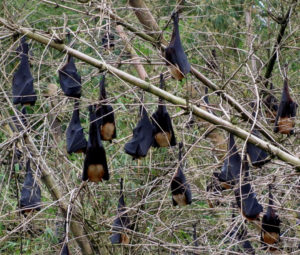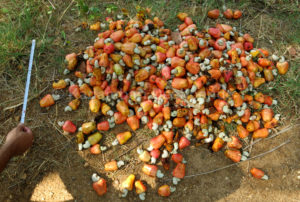Reflecting on over a decade of her own research in the Western Ghats, Kadambari writes about how bats have contributed to the plantation economy and ecology in Kerala over the years, and how films like Virus and Maheshinte Prathikaram portray this co-existence with care.
Kadambari Deshpande
I carried a pen and notebook when I went to watch the 2019 Malayalam film Virus in a Bangalore cinema theatre. I am not a film critic. I was there because I study bats in Kerala’s Western Ghats. Virus became, for me, a visual archive of what it must have been like for Kerala’s people to deal with the first Nipah virus outbreak in 2018. Before reaching the theatre, I was not sure of what to expect. A sci-fi medical thriller? A human drama on the tragedy? A condemnation of fruit bats—the putative suspects? Instead, what I experienced was captivating—the film’s deep insight into the delicate and tenuous relationship of the human world with the natural, wild world. It was also a reminder of what it actually meant to do research on bats in the times that were to come.
After the Covid-19 pandemic, and even before, bats have been much maligned and perceived negatively across nations and cultures, often disdained as ‘bad omen’, and associated with danger or horror. Fruit bats are commonly perceived to be orchard ‘pests’, while insectivorous bats are generally remembered for fouling sacred places with the stench of their guano. Ecologists and conservationists have been working hard to change these negative notions by highlighting the importance of bats for seed dispersal and pollination, or in controlling agricultural insect pests. However, being nocturnal creatures, bats remain under-represented in popular media on environment and ecology, and public appreciation of bats is still limited.

But, I realised that this was not the case in Kerala when I started my ecological research on bats in Kerala’s Agasthyamala ranges in 2011. Along with ecological studies, my work also involved listening to the experiences and narratives of local people about bats. In the initial days, I was amazed to learn that people did not just name them ‘wawwaal/വവ്വാൽ’—‘bat’ in Malayalam, referring to the commonly seen large fruit bats or Indian flying foxes, but also differentiated between ‘narichcheer/നരിച്ചീറ്’ and ‘njaru/ഞാറു’–types of insectivorous bats, distinguished by size and habits. I was even more impressed on seeing a small booklet on bats, with Malayalam names coined for different bat species with detailed descriptions. In Kerala, I was not busting bizarre myths about bats (as is usual elsewhere). Rather, I was taking in some positive narratives that people had to share. People had been observing fruit bats closely—somewhat like a routine—and learning about their ecology through their own experiences, and even through the transfer of practical knowledge across generations of people involved in plantation farming in Kerala. These people perceived bats to be more beneficial than harmful, and the reasons they gave were not typical, as if from a textbook or an environmental awareness program. Rather, they reflected lived experiences of how people observed, tracked, and accrued value from seed dispersal by fruit bats. People stated that bats ‘gifted’ them with seeds or nuts of valuable cash crops like cashew and areca. Fruit bats fed on the pulp/ juice of cashew and areca, and discarded the valuable seeds undamaged that piled up below feeding trees. Such aggregations of seeds by bats helped in efficiently collecting ‘ready-to-process’ nuts with lesser expenditure of money, time, and energy. Plantation owners even said that these seed aggregations led to a reduction in labour costs—labour shortages and escalating costs were a dear subject to the planters, especially with tough tasks like climbing tall and thin areca trees to get the fruits down. People who did not own these crops could get ‘free’ nuts through dispersal by bats. In some parts of Kerala, people also engaged in auctions of these valuable seeds aggregated by bats under roosts.

These observations aroused much interest when I first published a paper on such positive perceptions about bats.1 Many readers were either astonished or found them hard to believe. Scientist colleagues from Kerala and Africa shared with me that they had also observed seed aggregations by bats, but without linking this to how much people valued such aggregations. Perhaps these observations also challenged the preconceptions that scientists, including myself, may hold about local knowledge and perceptions about bats. This feedback then motivated me to explore, through detailed studies, what bats actually did in the process of eating fruits and dispersing seeds, and how these ecological processes translated into an important ‘ecosystem service’ for people in the context of plantation economy and ecology. For this, I expanded my research in five agroforestry landscapes along India’s Western Ghats, including in Kerala, to see how prevalent such narratives were across different socio-cultural settings.2
I found that, even at this larger scale, the perception that bats were more beneficial than harmful–was quite consistent! From the 168 interviews that I conducted in different areas, similar narratives of seed aggregations, easy collection of seeds, reduced costs, etc. came about. These reports also matched well with my independent ecological studies and measurements of bat seed dispersal in various plantations. Of course, not all was good news. Along with benefits, people also reported losses to some fleshy fruits such as banana, guava and mango, but these losses, compared to the total production, were perceived to be minor. In many ways, the economic benefits from bats were clearly significant enough to have become a part of local practice and lore—especially so in Kerala.
In 2018, the first Nipah Virus outbreak further expanded the dimensions of this work. I also included an analysis of likely disease risk from bats to people, based on my field observations on human-bat contact modes and data collected from existing studies on possible risk factors underlying bat-to-human virus transmission. To tie it all together, I connected my findings on bat ecology and social practices with the results of disease risk assessments, to evaluate the simultaneous benefits, costs, and risks from fruit bats to people in the Western Ghats. With the Nipah outbreak, I had imagined that negative perceptions would overshadow long-standing perceptions of bats as beneficial. But when I visited the same areas post-outbreak in 2019 and interacted with plantation communities again, I gauged that perceptions of benefits from bats had not faded away—people were just being more careful. I also noted that the outreach and safety advisories by government campaigns and local authorities were making a difference, at the level of village primary health centres (PHCs) and individual outlook.

But the risks of infection continue to be real, and fruit plantations could serve as emerging arenas of human-bat contact, as per my findings. Cashew plantations, for which benefits from bats were highest (bat dispersal contributed to nearly 50% of the collections), are of particular importance. Bats love cashew-apples for their juicy and aromatic pulp. Unlike mango or sapota which are generally harvested unripe, cashew-apples are left on trees till they ripen, increasing the chance of bat visitations. Further, in the cashew fruiting season in peak summer, bats may get more tired and have higher stress, which can increase the risk of viral transmission. Fruit bat females breed in summer and may have lower immunity as more bodily energy is directed towards reproduction, which can lead to more viral shedding, according to studies. Subsequently, at the time of seed collection, viral transmission may occur through inadvertent human contact with bat secretions on fruit surfaces.
In my study, I found that, interestingly, areas where people reported greater benefits from bats were also areas with a lower likelihood of viral risk. This correlation may be due to the different scales at which benefits and risks may be realized. Benefits are realized by people at the plantation level, but disease risks could manifest through a combination of both local (e.g. eating bat-bitten fruits) and regional factors such as climatic changes. At present, it is difficult to identify reasons for the pattern I found, for which we need more research. But nonetheless, this finding carries hope. It also suggests that to maximize the benefits from bats and minimize the risks—those that can be mitigated at the local level—a combination of alternative management practices and simple safety measures may help (e.g. wearing masks and gloves when collecting seeds, safe disposal of dead or injured bats, planting non-commercial fruit trees around plantations to divert bats from commercially valuable fruits). Going further, more research is needed on the ecological and social factors underlying human-bat contact modes to avert human health risks in future. Kerala, with its vibrant science-society interface and awareness discourses has set an example for the world to follow in dealing with such risks, and will continue to do so. Of course, all this is not to say that Kerala is a haven for bats. Hunting and killing bats, and habitat loss, are not uncommon here. Yet, one hopes that conservation and ecology-friendly viral risk-aversion efforts help Kerala overcome these threats to bats.
Such an approach is taken in Virus, where despite lethal risks, the reservoirs of Nipah virus–bats–were not vilified or disregarded in the film, which is its most emphatic and important message. The ending of Virus reminds us that bats have an equal right to live as we do. Understanding bats and their ecology is critical for safely coexisting with them. Remembering the protagonist’s father in Maheshinte Prathikaram, who spends nights trying to take a good picture of a short-nosed fruit bat visiting a banana flower, can inspire us to appreciate bats, from a safe distance.
Author Bio: Kadambari Deshpande has been studying bats since 2008 in the Western Ghats, and is currently a PhD candidate at the Ashoka Trust for Research in Ecology and the Environment, Bangalore. Her research interests include studying echolocation by insectivorous bats, seed dispersal by fruit bats, and human-bat relationships. She is also interested in conservation education and outreach to help people access the right information about bats, for the well-being of both bats and humans. She can be contacted at kadambari.deshpande@atree.org or kvd.novel@gmail.com.
Also read:
- Lakshmi Pradeep analyses the human-non-human relationships in the 2017 film, Parava, to talk about an emerging genre of Malayalam cinema: “cli-fi” or climate fiction
- Meera M. Panicker offers us a glimpse into Kadar ways of life, and how their everyday practices and their battles for forest rights serve as a lesson in Kerala’s current moment of environmental crisis.

Kadambari Deshpande’s well written article about bats is a pleasure to read. Factual, without overtones about the good aspects and equally well balanced account of their easily mitigatable risks.
The long and not so easy work done over many years reflects and the sense of authenticity and authority is unmistakable. Excellent read.